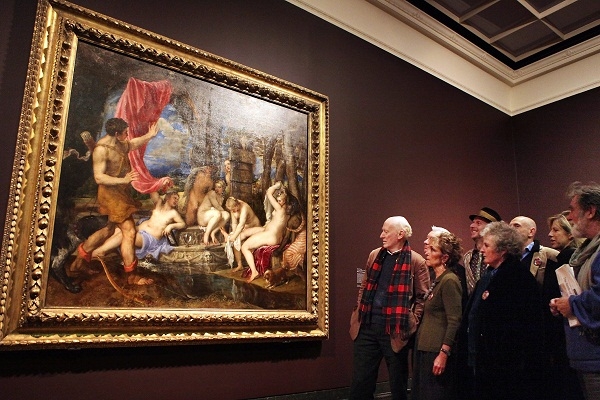Metamorphosis, a temporary exhibition at the National Gallery, London, showcases a range of contemporary artistic responses to Renaissance painter Titian’s Diana and Actaeon and Diana and Callisto metamorphosis paintings, inspired by Ovid. Daisy Dunn looks at the new poetry inspired by the collaboration.
When the hapless youth Actaeon peeled back a curtain dangling in a forest glade, he might just as well have been uncovering a religious icon as playing voyeur to a bevy of naked beauties. This, at least, is the way Titian saw it when he decided to paint the luscious velvetine hanging before the unwitting voyeur in his Ovid inspired canvas, Diana and Actaeon. Titian knew that patrons such as Philip II of Spain, recipient of his poesie ‘poetical paintings’, veiled both religious and erotic artworks from sight upon their walls. The curtain Actaeon draws back to reveal the bathing goddess Diana is Titian’s means of endorsing Ovid’s famous line, ‘what blame is there in a mistake?’ Actaeon was punished for his perversion by being turned into a stag. No such punishment for the voyeur of contemporary artist Mark Wallinger’s response to the myth, which features a fully-fitted bathroom, closed in but for some peep-holes and a window covered by a blind (not a curtain), inhabited by a successive stream of nude girls named Diana. How tantalizing. &”If I tilt my head this way I can just about see her through the slats of the blind. God. What am I doing?!”, a viewer exclaims. Anyone can become Actaeon. Actaeon can be anyone.
Such is the curious spark of inspiration that courses through many of the fourteen poems commissioned for the collaboration. Several stages removed from Actaeon, the poet can either become him, or become a voyeur of him. Simon Armitage cautiously pictures ‘the pink-red curtain of noon, drawn back’ as he, Actaeon, is metamorphosed from man into beast, ‘from calf and hip, curve and cleft,/from a writhing feast of fruit and meat…’ while Tony Harrison, much like Mark Wallinger, questions, ‘Haven’t you half thought that while you view/Actaeon’s intrusion you’re intruding too?’
Wendy Cope metamorphoses, instead, into the column-concealed girl she dubs ‘Actaeon’s Lover’, peering out from the shadows of Titian’s Diana and Actaeon, ‘I am the one half hidden by a pillar,/Gazing out at him with loving eyes’. Diana, who cast the spell, is every inch Actaeon’s ‘murderess’. Patience Agbabi, also, wishes, too little too late, that Actaeon had looked at her, cast in the role of Diana’s servant, black-skinned and luxuriously enrobed, ‘clad in cloth finer than cirrus’. ‘I want you, Actaeon. I wish I were/shroud white; O that you’d notice me and mouth/each monumental curve.’ ‘Too harsh!’ was Diana’s spell, Agbabi cries in Ovidian guise. How is one to value the price of a look?
Hugo Williams plays quite another Actaeon, one somewhat less innocent. He enters a reverie, behind a curtain, filled with girlfriends past, ‘each of them holding up her year/and smiling attractively.’ The scene inspires panic, not so much at what he has seen, but at what he cannot see in himself, ‘Alas, I fled the scene,/dogged by indecision and regret,/torn apart by my imaginings’. Seamus Heaney, too, ponders Actaeon’s lack of culpability in his breathless verse inspired by the Death of Actaeon, Titian’s sequel canvas to the Diana and Actaeon that shows his actual metamorphosis. For Heaney, once Actaeon is a stag, it is ‘as if he’d sought/That virgin nook deliberately, as if/His desires were hounds that had quickened pace/On Diana’s scent…’
Even as spectator, it’s sometimes hard to know exactly why it is that one looks. More than anything else, Actaeon, and poet, and viewer, and reader are eternally plagued by the impossibility of the Greek adage, γνῶθι σεαυτόν know thyself.
Daisy Dunn
The arts of voyeurism






Comments